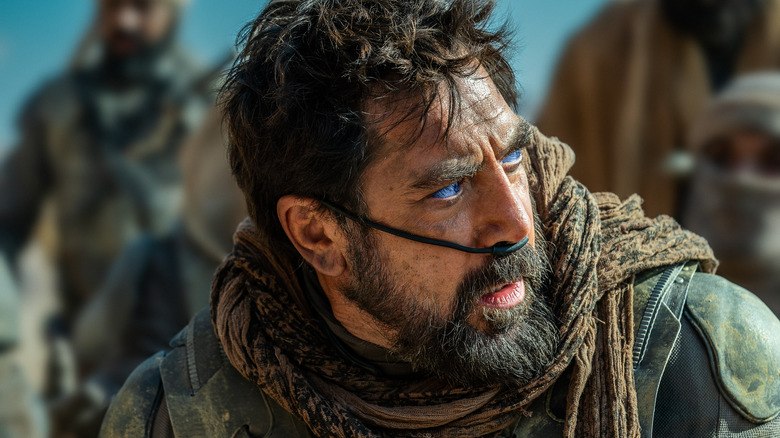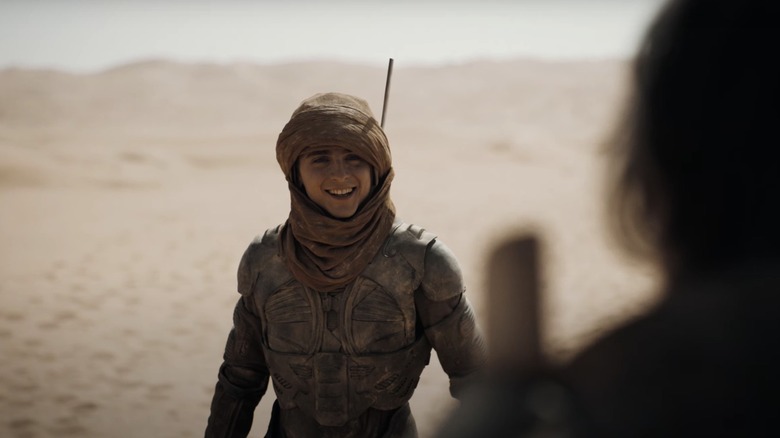Dune 2's Filming Conditions Had People Passing Out Left And Right
Arrakis. Dune. Desert planet. If you think Anakin Skywalker hated the sands of Tattooine, he would have loathed living on Arrakis.
"Dune: Part Two," the giant sci-fi sequel due in theaters on March 1, 2024, is an adaptation of the second half of Frank Herbert's celebrated 1965 sci-fi epic. It follows the 2021 Denis Villeneuve film "Dune," which was impressively designed and beautifully photographed, ultimately winning six Academy Awards. That Villenueve's film was oblique and somewhat difficult to follow was appropriate, seeing as obliqueness was the primary feature of Herbert's novel. "Dune" is an infamously complicated and expansive work suffused with a massive unique mythology that required a glossary of terms. It's so complicated, in fact, that Villeneuve felt the need to split the story in half, making two films instead of one. As a result, the first film ends on kind of a cliffhanger.
In brief, the bulk of the story of the first film takes place on the desert world of Arrakis, the only known source of the spice, a trippy hallucinogen that also makes space travel possible, somehow (it's kind of vague). Arrakis was ruled by the evil House Harkonnen for decades, but the Emperor recently installed the benevolent House Atreides in the Harkonnens' place. It seems, however, that this was a scheme to allow the Harkonnens to return in secret and kill off the Atreides. The young Paul Atreides (Timothée Chalamet) escaped the Harkonnen attack and fled into the care of the Fremen, the remote, desert-dwelling natives of Arrakis. That was where the first "Dune" ended.
The desert scenes in "Dune" and "Dune: Part Two" were filmed in Wadi Rum, Jordan, and in the Liwa Oasis in the United Arab Emirates. These are actual desert locations and came with their own natural heat. Actor Austin Butler, who plays the evil Feyd-Rautha in "Part Two," was recently interviewed by Variety, and he revealed that the heat on the set was so excessive that it began to hinder certain people working on the picture. He also revealed that it was so hot that people were "passing out from heat stroke." But as it turns out, it wasn't the heat of the desert that contributed to the heat stroke in question. Instead, it was a scene shot in Budapest, Hungary that made people dizzy. While shooting in Hungary, the temperature rose to 110 degrees.
Feyd-Rautha
Butler's character, the villainous Feyd-Rautha, is meant to stand as a political counterpoint to Paul Atreides. In the book, Paul eventually becomes the Kwisatz Haderach, a Messiah figure to the Fremen. He will rally the Fremen and stage a massive desert counterstrike against House Harkonnen, even going so far as to train and ride the massive sandworms that populate the deep desert. Feyd-Rautha, meanwhile, is the Harkonnen "golden child," and the wicked family positions him as a direct rival to Paul. The film will climax with a knife fight between Paul and Feyd.
In "Dune: Part Two," Feyd-Rautha was envisioned as being pale, white, and bald. The baldness, it seems, was achieved with makeup, and the latex cap affixed to Austin Butler's head didn't make filming in the heat any easier. Eventually, however, the heat became something everyone could survive through together, causing a weird sense of camaraderie. As Butler said:
"It was 110 degrees and so hot. I had the bald cap on, and it was between two soundstages that were just these gray boxes of 200-foot walls and sand. It became like a microwave. There were people passing out from heat stroke. And that was just my first week. [...] It really bonds the entire crew. [...] There's something so humbling about being in such an uncomfortable environment."
During an appearance on the Graham Norton Show, Butler confirmed that it wasn't a desert scene that caused this reaction. It was during the shooting of his character's big introduction sequence, where Feyd-Rautha is seen battling surviving prisoners of the Atreides clan in a giant open arena. The entire sequence is shot in black and white and can be glimpsed in the trailers for "Dune: Part Two." It serves to establish how deranged Feyd-Rautha is, and how he thrives when committing acts of violence. But when you watch the scene in question, just remember that everyone working on the picture was sweltering in the 110-degree heat.
Director Denis Villeneuve is also quoted by Variety saying that he deliberately took a break between filming "Dune" and "Dune: Part Two" as the heat was a legitimate issue. The first film is 155 minutes and the second will be 167 minutes. That is a lot of time in the heat, and that break gave everyone a much-needed rest.

